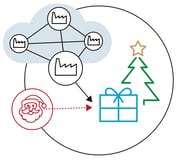5 Facts About Advanced Planning and Scheduling
Brian Hoey - July 11, 2019

 We’ve all been there at one point or another: you’re scheduling production for a large, complex item like an automobile in a plant that produces multiple different models. Your materials and capacity are relatively well synced, and your plans for the rest of the week or month seem pretty stable. Then, all of a sudden, a huge rush order comes in from an important client. All of a sudden, you're scrambling to allocate the materials and capacity necessary to slot this order into your existing plans. You pull resources from one order to give this one the resources it needs, but that has a complex ripple effect through your ordering flows; by the time you’re done reworking the schedule, your production plans are confusing and far from optimal.
We’ve all been there at one point or another: you’re scheduling production for a large, complex item like an automobile in a plant that produces multiple different models. Your materials and capacity are relatively well synced, and your plans for the rest of the week or month seem pretty stable. Then, all of a sudden, a huge rush order comes in from an important client. All of a sudden, you're scrambling to allocate the materials and capacity necessary to slot this order into your existing plans. You pull resources from one order to give this one the resources it needs, but that has a complex ripple effect through your ordering flows; by the time you’re done reworking the schedule, your production plans are confusing and far from optimal.
In moments like these, you might think to yourself, “advanced planning and scheduling would be really convenient just now.” And you’re probably right. Among other things, advanced planning and scheduling works to give manufacturers the ability to change their plans on the fly in a way that still retains value. How does it do so, exactly? Read on to find out.
1. It Can Increase Productivity By Reducing Downtime
In point of fact, advanced planning and scheduling, or APS, can do this in a number of ways, but one of its most important functions is to make sure that machine and station uptime is optimally utilized. How does it do this? First, it creates a clear picture of available resources on your factory floor plus available raw materials. From there, it matches the utilization of those two elements to one another in as synergistic a manner as possible by considering them holistically, rather than through the prisms of separate silos. By ensuring that demand, capacity, and resources are aligned properly, APS reduces the likelihood that your machinery stands idle while you wait for necessary parts to materialize. Likewise, it reduces the odds that your machines will break down due to over-strained capacity. Rather than producing products haphazardly, you're able to fit each process into an appropriate time interval in order to minimize wasted time.
2. It Decreases Raw Material Waste
In much the same way that APS can decrease downtime by creating alignment between sourcing and production scheduling, it can also decrease raw material waste by the same token. Imagine you’re working with a plant that has low information visibility and a number of siloized planning processes: your expectation would be that procurement wouldn’t have enough insight into production to order optimally. Thus, you would either have parts shortages (resulting in disruptions and lost revenue), or you would have overages, with raw materials paid for, stored, and yet sitting idle. In the worst case scenario, raw materials would be paid for, stored, and then forgotten about entirely, leading to redundant parts procurement when demand for a particular part or product ticks up again. APS effectively stops things like this from occurring by creating more oversight into the interactions between production scheduling and raw material sourcing. In this way, it helps promote a leaner production chain.
3. It Can Reduce Disruptions Through Real-time Planning
This fact basically speaks to the example we used in the opening paragraphs. Without an advanced, digital planning infrastructure (which is essentially what APS is at heart), an unexpected demand spike or a large customer order could mean that your entire meticulously crafted plan has to go out the window. From there, your new plan would have to be created under enormous time pressure, inevitably leading to sub-optimal operations in the short term. The reason for this is that, from a practical perspective, humans can’t really plan in real time. As new situations emerge, planners require time to adapt and consider potential options for moving forward. With a digital planning flow, on the other hand, you can visualize potential options instantaneously and choose the one that will be least disruptive within the context of your current workflows. Thus, real-time planning becomes a real possibility, leading to increased agility and a decrease in disruptive, non-optimized replannings.
4. It Acts as a Complement to Existing ERP Systems
It’s a common misconception that APS and ERP are essentially the same thing—on the contrary, they’re related but ultimately complementary processes. ERP, or enterprise resource planning, is all about integrating disparate business functions, while for our purposes APS speaks specifically to the interplay between production scheduling and procurement. This means that while ERP might cover longer-term goals and initiatives that require coordination between multiple different business functions, APS is more likely to come into play for shorter (i.e. daily, weekly, and monthly) time periods in order to make sure that production planning is fitting into larger corporate goals and initiatives. In this way, intelligent production planning acts as a complement to more broadly-scoped functions like ERP.
5. It Goes Hand in Hand with Industry 4.0
If you’re a production planner working in manufacturing right now, there’s a decent chance that Industry 4.0 is at least hovering in the back of your mind. This means that if and when you consider potential new workflows, technologies, or paradigms, you likely do so with an eye towards future-proofing your processes and ensuring continued success in new technological environments. Luckily, because APS thrives in highly-digitized environments, it’s an ideal fit for new digital paradigms like the ones emerging from Industry 4.0. If, for instance, you’re striving for an Industry 4.0-enabled smart factory, you might conceivably have internet of things (IoT) sensors transmitting live data from your factory floor to your production control tower. As this data becomes available, your APS systems could use it to create more accurate predictions and suggest potential improvements to your production plans. By the same token, an Industry 4.0 supply chain built on automation could easily integrate with your APS flows in such a way as to empower automated adjustments to procurement quantities based on up-to-the-minute planning data. In this way, your production planning grows to encompass a host of new data sources and areas of potential automation. The result is that human planners are more empowered than ever before to mitigate disruptions and add value.
LATEST POSTS
- Understand Why Production Planning Needs Specialized Solutions
- Understand Circular Economy in The Manufacturing Industry
- How Can Industry 4.0 IT Integration Be Achieved Smoothly?
- The Significance of Order Sequencing in Discrete Manufacturing
- How to improve your Supply Chain Management: The Power of Control Towers



